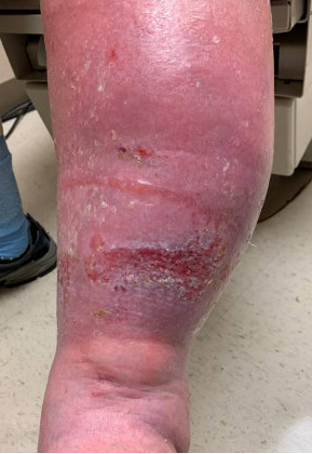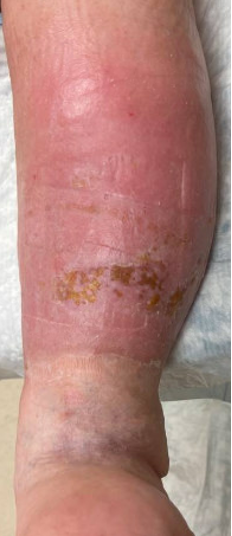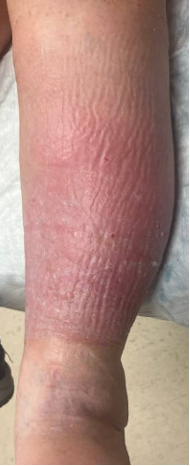
Emily Greenstein, APRN, CNP, CWON, FACCWS is a Certified Nurse Practitioner at Sanford Health in Fargo, ND. She is certified as an Adult-Gerontology Nurse Practitioner through the American Academy of Nurse Practitioners. She has been certified in wound and ostomy care through the WOCNCB for the past 9 years. At Sanford, she oversees the outpatient wound care program, serves as chair for the SVAT committee, and is involved in many different research projects. Emily Greenstein is a paid consultant for Solventum.
Greenstein_Current-Dialogues-in-Wound-Management_2024_Article-3
INTRODUCTION: It is estimated that up to 3/1000 people have leg ulcers, with the prevalence increasing to 20/1000 people after the age of 80.1 Clinicians should follow an evidence-based treatment approach for treating VLUs which includes wound hygiene, exudate management, compression therapy, and appropriate infection/inflammation control. The patient may also require a vascular consultation to manage the underlying venous insufficiency.VLUs are usually highly exudative, as such, managing the exudate while protecting the periwound skin is a key component of the treatment plan. Chronic venous hypertension can cause leakage of fluid and proteins from the vein walls resulting in increased exudate.2 Wound exudate, the fluid that leaks out of blood vessels, is part of a natural healing mechanism that signals the immune response in acute wounds. However, in chronic wounds, the exudate is highly alkaline which impedes healing, can be difficult to manage, and can cause maceration of the periwound skin, pain, and distress to the patient.3 Excessive wound exudate can accumulate at the wound bed causing maceration of the wound surface, resulting in cells that are overhydrated and vulnerable to minor trauma, along with an increased risk for the development of hypergranulation tissue.3 Maceration of the periwound skin can also occur, potentially leading to wound enlargement, an increased risk for infection, and impaired healing.Strategies to manage highly exudative VLUs include periwound skin protection, primary and secondary dressing selection,
and the use of therapeutic compression. The ideal primary and secondary dressings should conform to the wound surface, prevent dead space, and absorb a large amount of exudate. The goal is to wick the exudate away from the wound surface thus preventing maceration.Poor exudate management can lead to periwound maceration or desiccation, which can be the result of a mismatch between the absorptive capacity of the dressing, the frequency of dressing changes, or both. If maceration is severe enough, it may damage the existing epithelium to the point that healing is slowed or stopped. Conversely, desiccation occurs from insufficient moisture.4 Dressings with high absorptive capacity may promote periwound dryness if exudate is not appropriately assessed and further changes are not made to the dressing combinations or frequency of dressing changes.Ideal dressings for managing high levels of exudate should wick exudate away from the periwound skin while maintaining an optimal wound healing environment. Super-absorbent dressings such as the 3M™ Kerramax Care™ Super-Absorbent Dressings wick fluid both horizontally and vertically, allowing the moisture to be retained in the dressing rather than on the periwound skin. Kerramax Care Dressings can be placed under therapeutic compression for added absorbency for these highly exudative VLUs. Compression therapy at 40 mmHg at the ankle is the gold standard for the treatment of VLUs. This treatment helps to reduce lower leg edema, improve venous return, and aid in wound healing.2 Many options for compression therapy are available, including single layer, multilayer, long-stretch, short-stretch, and stockings. The type of compression therapy used should be based on the patient’s needs. A multilayer compression system that can provide compression at 35-40 mmHg for patients with an ankle brachial pressure index (ABPI) ≥ 0.8 is the 3M™ Coban™ 2 Two-Layer Compression System. For patients with an ABPI ≥0.5, the 3M™ Coban™ 2 Lite Two-Layer Compression System may provide clinical benefits.5,6 This multilayer compression system can provide sustained therapeutic compression for up to 7 days.Case Report:A 66-year-old male with a history of venous stasis ulcers, lymphedema, obesity, and type 2 diabetes was treated at a rural wound care center for a venous stasis ulcer. He presented to the wound center with heavily exudative wounds and blistering to
his left lower leg (Figure 1). The patient reported that he had not been wearing his compression stockings regularly as prescribed. The patient was treated with weekly dressing changes consisting of a 3M™ Cavilon™ Advanced Skin Protectant applied to the periwound skin, 3M™ Promogran Prisma™ Collagen Matrix with ORC and Silver, Kerramax Care Dressing, and Coban 2 Compression System to control the edema. Promogran Prisma Matrix was utilized to help create a moist wound environment conducive to granulation tissue formation, epithelialization, and optimal wound healing. The patient received once a week dressing changes until Day 21, at which time his wound had healed, and he was transitioned back to his home compression stockings (Figures 2-3).




DISCUSSION: Treating patients with VLUs can be challenging due to heavy exudate, pain, and underlying inflammation/infection. Wound debridement, advanced wound care dressings, and compression therapy can be used to manage these wounds as depicted in the case report above. Here, the evidence-based approach utilized a combination of Cavilon Advanced Skin Protectant, Promogran Prisma Matrix, Kerramax Care Dressings, and Coban 2 Compression System to mange a patient with a venous stasis ulcer. While this treatment plan resulted in wound healing, patients with VLUs are at increased risk for recurrence. Thus, it is important to educate patients on the need for lifelong treatment with compression garments to prevent recurrence.
References
- Nelson EA, Adderly U. Venous leg ulcers. BMJ Clinic Evid. 2016;2016:1902.
- Chatterjee SS. Venous ulcers of the lower limb: Where do we stand?. Indian J Plast Surg. 2012;45(2):266-274. doi:10.4103/0970-0358.101294
- Cutting, KF. Wound exudate: composition and functions. Br J Community Nurse. 2003;8(9 Suppl):4-9. doi:10.12968/bjcn.2003.8.sup3.11577
- Thomas S. The role of dressings in the treatment of moisture-related skin damage. World Wide Wounds. 2008; available from: http://www.worldwidewounds.com/2008/march/Thomas/Maceration-and-the-role-of-dressings.html.
- O’Meara S, Cullum NA, Nelson EA. Compression for venous leg ulcers. Cochrane Database Syst Rev. 2009;(1):CD000265. doi:10.1002/14651858.CD000265.pub2
- Moffatt CJ, Edwards L, Collier M, Treadwell T, Miller M, Shafer L, et al. A randomized controlled 8-week crossover clinical evaluation of the 3M Coban 2 Layer Compression System versus Profore to evaluate the product performance in patients with venous leg ulcers. Int Wound J. 2008;5(2):267-279. doi:10.1111/j.1742-481X.2008.00487.x
NOTE: Specific indications, contraindications, warnings, precautions and safety information exist for these products and therapies. Please consult a clinician and product instructions for use prior to application. Rx only.
As with any case study, the results should not be interpreted as a guarantee or warranty of comparable results. Individual results may vary depending on the patient’s circumstances and condition.
Patient data and images courtesy of Emily Greenstein, APRN, CNP, CWON-AP, FACCWS.
© Solventum 2024.

